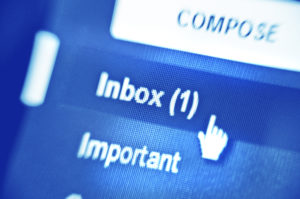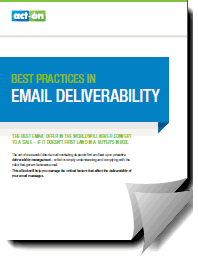 After this year’s Email Evolution Conference in Miami, the last panel left the email marketing and deliverability communities with plenty to talk about. Four deliverability experts from major ISPs gathered to answer questions about deliverability – and their responses were extremely candid. The panel included:
After this year’s Email Evolution Conference in Miami, the last panel left the email marketing and deliverability communities with plenty to talk about. Four deliverability experts from major ISPs gathered to answer questions about deliverability – and their responses were extremely candid. The panel included:
- Paul Rock, a senior programmer at AOL Inc.
- Matthew Moleski, senior director of Customer Security for Comcast
- Sri Somanchi of Gmail’s Anti-Spam Team
- John Scarrow, a general manager at Microsoft
They responded to questions from the audience as well as a team of experts: Dennis Dayman, chief privacy and security officer for Return Path, and Ryan Phelan, vice president of global shared services for Acxiom Digital Impact. The discussion was focused on what their organizations do to improve inbox placement, and best practices for deliverability today and in the future.
Engagement is Key
We’ve known for a while that engagement is a critical factor in deliverability. Traditionally, marketers have measured their engagement by looking at opens and clickthroughs, so it’s not a huge leap to consider that ISPs look at these, too. But in fact, the four panelists said this is an over-simplification. Each ISP has hundreds of determinants to filter the desirable emails from the undesirable, and while opens are definitely measured and counted in an email’s favor, clicks are not actually tracked (apparently for both privacy and technical reasons).
 So what does an ISP consider as engagement? Any sort of positive interaction with an email is a good sign: opening an email, filing an email (in anything but the junk folder, of course), replying to an email, adding the sending address to contacts, moving an email that landed in the spam filter back to the inbox. Sri Somanchi said that moving emails out of the spam folder is a much more powerful positive signal than the spam button is as a negative signal.
So what does an ISP consider as engagement? Any sort of positive interaction with an email is a good sign: opening an email, filing an email (in anything but the junk folder, of course), replying to an email, adding the sending address to contacts, moving an email that landed in the spam filter back to the inbox. Sri Somanchi said that moving emails out of the spam folder is a much more powerful positive signal than the spam button is as a negative signal.
Negative signals are obvious: a spam complaint, deleting an email without reading, and moving an email to the junk folder are all indicators that an email is unwanted, which could trigger the spam filter the next time you send to that address. We now know that clicks are not tracked, but that is not to say that clickthrough metrics are not valuable. For the marketer, they remain good indicators of positive engagement, and should be analyzed when you determine how effective your email campaigns are.
A “spammy” subject line by itself isn’t enough for an ISP to mark an email for the spam folder, but your recipients may not want to open an email with a spammy subject line, or they might flag these as spam. You’re much better off to be mindful of your word choice and create brief and enticing subject lines that will entice readers rather than trying to fool them into opening an email.
Reputation
The panelists were asked about sender domain and IP reputation. Adhering to basic authentication standards such as SPF, DKIM, and DMARC is imperative. If the ISP cannot be sure you are who you say you are, your email will either redirect to the spam folder or not be delivered at all. Remember: the ISP works for the subscriber (not the marketer) and will not risk their security.
Warming Up and Ramping Down
Once authentication is in place, senders should warm up a new IP. Likewise, senders should ramp up on a new campaign, and ramp down inactive recipients. Google’s marketing teams implement their own ramp-down strategy: they gradually decrease the frequency of emails to inactive recipients, and eventually ask whether the recipient wants to continue getting their emails. Their recommended ramp-down schedule looks like this:
- If you’re sending daily, switch to once a week
- If you’re sending weekly, switch to once or twice a month
 If there is still no engagement after three to six months, ask: do you want to continue hearing from us? If there is still no answer, take them off your list.
If there is still no engagement after three to six months, ask: do you want to continue hearing from us? If there is still no answer, take them off your list.
Paul Rock said that AOL has its own blacklist (and getting listed on that one is an automatic block at any AOL domains), but no other ISP representative admitted to using a particular blacklist. Being blacklisted is just one factor in a long list that determines reputation and placement.
The message the Gmail, Microsoft, Comcast, and AOL professionals are giving us is that email and the inbox have changed: Deliverability is now increasingly personal. Your inbox is different from mine and that email about the huge sale on Saturday morning may be valuable to me but may go straight to your spam folder. A marketer may have an excellent sending reputation, but their sent email will not make it to the inbox if the intended recipient has marked that sender’s emails as spam.
And conversely, if your email is wanted – if your recipient has opened your email, or replied to it, or especially if they have taken the time and trouble to move it from a junk folder to a main folder – that email is much more likely to make it into that inbox the next time. Email deliverability is increasingly predicated on the recipient’s unique behavior.
ISPs are businesses with their own marketing teams, and you’d predict that they follow some key best practices. Here’s what the Gmail staff recommends to the Google marketing team:
- Acquisition: start by following best practices when getting people to opt in
- Engagement: don’t send the same thing to everyone
- Metrics: find a way to meaningfully track recipient engagement
- Amount: ramp-up at the beginning and ramp-down inactive recipients
- Opt-out: make sure that recipients can easily unsubscribe
 The message, more than ever before, is to send email that’s tailored to your recipient. That means paying close attention to segmentation, sending email that is highly relevant to the recipient, and giving that recipient a compelling call to action to engage with. Make your email worth their time, and your deliverability will improve.
The message, more than ever before, is to send email that’s tailored to your recipient. That means paying close attention to segmentation, sending email that is highly relevant to the recipient, and giving that recipient a compelling call to action to engage with. Make your email worth their time, and your deliverability will improve.
Want to learn more tips to help make sure your emails make it to the inbox? Check out this whitepaper: Best Practices in Email Deliverability.
